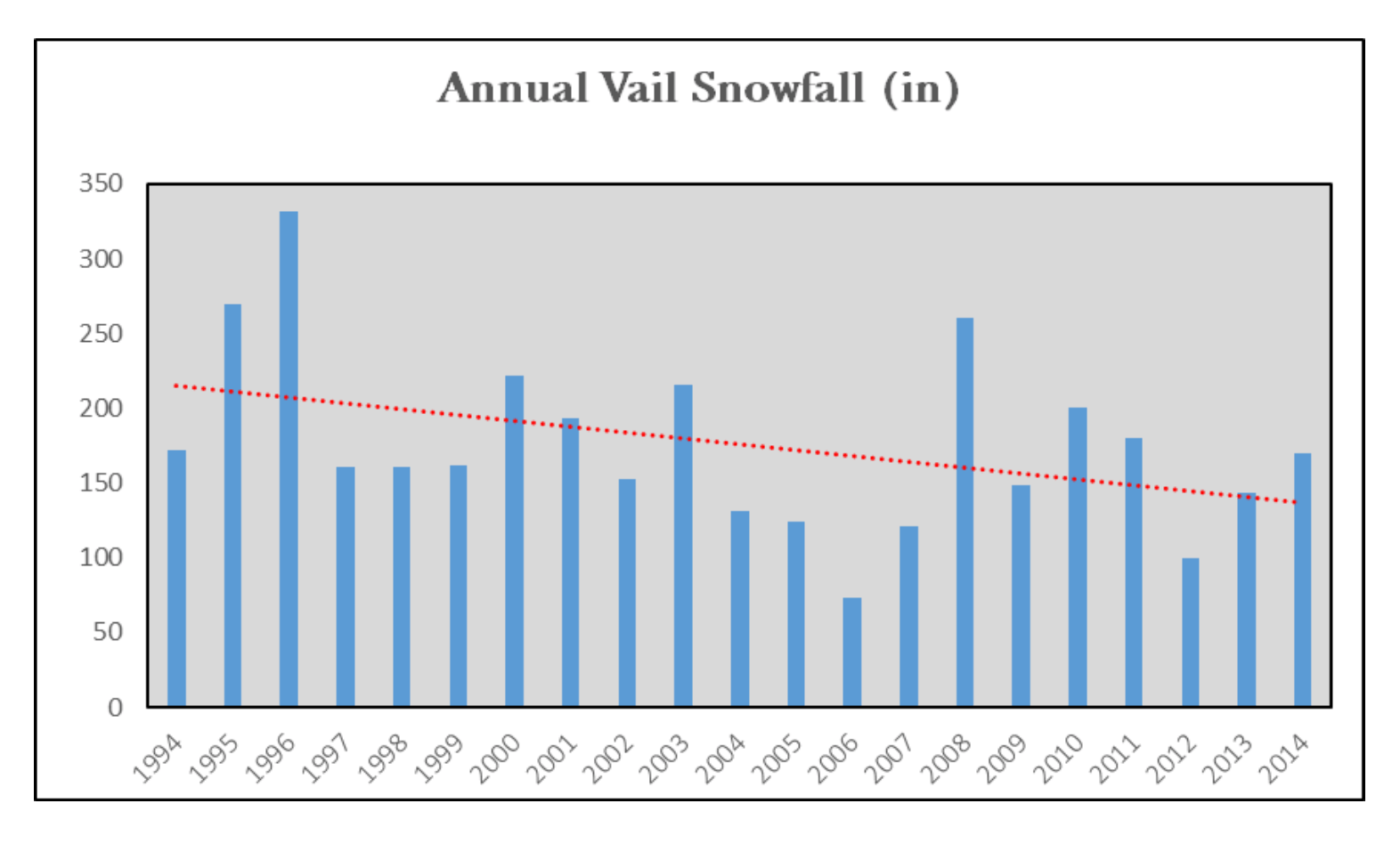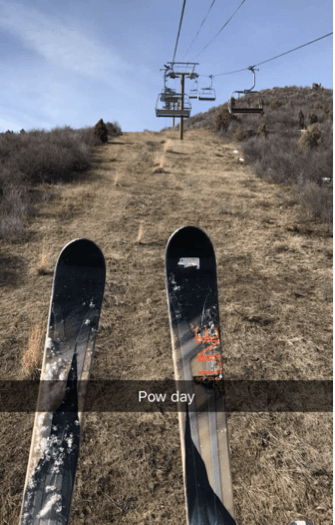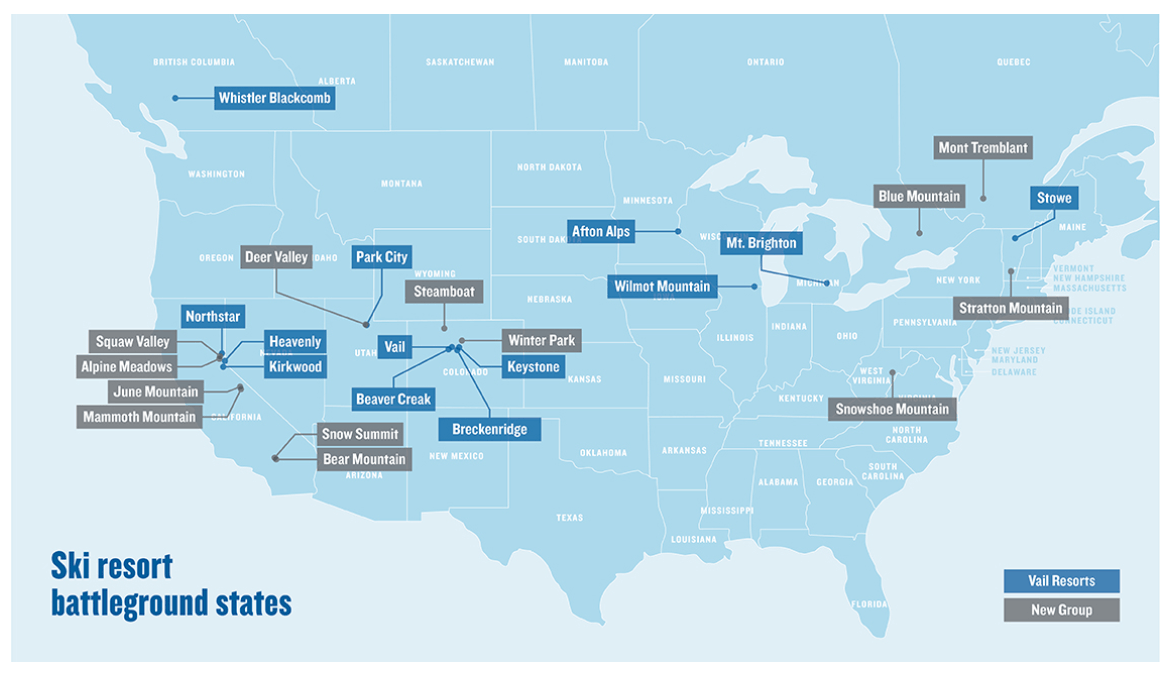Is Après-Ski Becoming the Main Event? The Impact of Climate Change on the Future of Vail Resorts

Rob Katz, CEO of Vail Resorts, has a particular question on his mind today – Will Vail be able to welcome skiers to its slopes next week? Opening day has already been delayed due to poor snow conditions, and while management is optimistic, the outcome of a predicted storm this weekend may be the deciding factor. [1]
Rise in Temperature, Decline in Snowfall
Climate change has impacted Vail’s most critical supply chain input – snow. With the average global surface temperature rising by 1.5 degrees Fahrenheit between 1880 and 2015 [2], average annual snowfall has been on the decline, as shown in Figure 1. [3]
FIGURE 1
The reality of these statistics affect Vail’s snow supply in several ways:
- Increased reliance on artificial snowmaking technology – Natural snowfall, especially during early season, is extremely variable. Vail needs to rely on snowmaking to guarantee a snow source throughout the season.
- Increased reliance on a consistent water source – Vail’s ability to procure artificial snow is dependent on its access to a water supply. Vail is subject to water regulations and restrictions enforced by federal, state, and local governments. [4]
- Lower snow base quality – Vail relies on cold temperatures and natural precipitation throughout the season to maintain a consistent, quality snow base.
If Vail is unable to maintain its snow supply, it will face critical operational implications. Being fully operational in time for the Christmas and New Year holidays is critical for a profitable year. Today, about 70% of resorts can achieve an opening day by December 15. In modeled climate scenarios, this percentage decreases to 35% in 2050 and less than 23% in 2090. [5] Vail also faces the risk of closing prior to spring break holiday, another massive revenue generating period.
Even when the resorts are open, if snow conditions are poor, customers may become dissatisfied which leads to lower overall traffic and thus, less profitable operations. Figure 2 illustrates less than ideal conditions at Beaver Creek Resort in late March this year.
FIGURE 2
Taking Action Today
Vail is acutely aware of these challenges and has taken action to mitigate risks. In the short-term, the company is focusing on:
- Investing in robust snowmaking systems – Vail continues to invest in advanced machinery to maximize artificial snow production. Its newest machines include low-energy technology to reduce carbon emissions.
- Enhancing off-mountain guest experience – Vail is developing attractive lodging, dining, shopping, and leisure options to create a comprehensive guest experience. This will help visitors to have a positive, memorable experience, regardless of snow conditions.
- Developing summer programming – Vail has spent $41 million to build out its Epic Discovery program which focuses on off-season activities including zip lines, climbing walls, and outdoor playgrounds. [6]
Investing in the Future
In addition to short-term tactics, Vail recognizes the gravity of this situation on its resorts’ long-term viability and has made notable long-term plays:
- Commitment to zero footprint by 2030 – Vail recently publicized its commitment to striving for zero net emissions, waste to landfill, and net operating impact to habitat by 2030. It has begun to reduce emissions through investments in efficient grooming equipment, green building design, renewable energy sources, and carbon offset programs. [7]
- Partnerships with climate and energy policy organizations –Vail is a member of both Ceres Business for Innovative Climate and Energy Policy and RE100. These relationships help to Vail to tackle climate change on a larger scale. [7]
- Diversification of resort locations – Vail is acquiring resorts in varied geographies to diversify risk resulting from weather patterns. Figure 3 highlights its U.S. footprint. [8] Vail has acquired resorts in Canada and Australia and is currently focusing on opportunities in the Japanese and European markets. [6]
FIGURE 3
Looking Ahead
While it’s evident that Vail is taking action to address climate change, I have several additional recommendations for Katz and his team:
- Maximize mid-season attendance through targeted events – The probability of ideal snow conditions in highest during mid-season. Vail should develop new events to attract a large volume of visitors during non-holiday, mid-season weekends.
- Embed customers in the Vail ecosystem – Vail should continue to look for ways to engage and retain customers through attractive membership programs, superior customer service, and unique product offerings.
- Partner with U.S. Ski and Snowboard and the International Ski Federation – These governing bodies have a close pulse on how the ski industry is affected by climate change on a global scale. Through this partnership, Vail can identify related risks and opportunities at a quicker pace.
Additional Considerations
A few other elements to reflect on:
- What will happen if the water supply for snowmaking is threatened? Are there non-water alternatives being explored?
- As Vail diversifies internationally, should they continue to acquire resorts or consider new development? What environmental restrictions do they face abroad for new development?
Despite the ever-present risks surrounding snow supply, I am optimistic that Vail will aggressively and creatively confront these challenges.
(Word Count: 788)
[1] Miller, Scott, “Next snow in Vail is expected this Friday, but how much is unclear,” Vail Daily, November 13, 2017, http://www.vaildaily.com/news/next-snow-at-vail-is-expected-on-friday-nov-17-the-resorts-opening-day/, accessed November 2017.
[2] Henderson, R. M., et al, Climate Change in 2017: Implications for Business (HBS No. 317-032)
[3] Donna Bebb, “Climate Exposure Impact on Equity Valuation: Case Study of Vail Resorts, Inc,” Steyer-Taylor Center for Energy Policy and Finance. http://media.law.stanford.edu/organizations/programs-and-centers/steyer-taylor/Vail_Final.pdf, accessed November 2017.
[4] Vail Resorts, 2017 Annual Report, p.87.
[5] Wobus, Cameron, et. al, “Projected climate change impacts on skiing and snowmobiling: A case study of the United States,” Global Environmental Change 45 (2017): 3, https://ac.els-cdn.com/S0959378016302849/1-s2.0-S0959378016302849-main.pdf?_tid=c931fe5c-ca5f-11e7-b3e8-00000aab0f02&acdnat=1510790020_f36d9995b9db94a57ece768af388c3a6, accessed November 2017.
[6] Vail Resorts, “2017 Investors Conference,” PowerPoint presentation, March 14, 2017.
[7] Vail Resorts, “Epic Promise,” https://www.vail.com/the-mountain/more-options/sustainability.aspx, accessed November 2017.
[8] King, Danny, “Melting snow: The consolidation of the ski resort industry,” Travel Weekly, November 8, 2017, http://www.travelweekly.com/Travel-News/Hotel-News/Melding-snow-consolidation-ski-resort-industry, accessed November 2017.






I think each of the three initiatives you highlight in the short-term section make a lot of sense both in the short-term and in the long term. I’m not so convinced that their commitment to zero footprint and partnerships with organizations will have much of an impact on the company’s long-term survival, even though those efforts are noble. For Vail to stick around through the next century, I think they’re going to need to lean on investments in snowmaking, non-ski activities, and location diversification, as you mentioned. As part of these last two initiatives, my guess is that they’ll start thinking about aggressively expanding into non-mountain outdoor recreation, hospitality, and real estate.
I also like your recommendations, but I wonder how valuable a formal partnership with U.S. Ski & Snowboard and the ISF would be in terms of identifying risks. I figured that these parties understand that they have shared interests in preserving winter sports, so my assumption is that climate change information is already being shared among this community.
Another thing I was wondering is how big of an impact increased snowmaking has on Vail’s bottom line. This ESPN article has some numbers that some people might find interesting: http://www.espn.com/action/freeskiing/story/_/id/8809682/cost-snowmaking
This other article has a great discussion of snowmaking operations (what technology is required, types of machines, what factors influence efficiency, etc.): http://emsenv.com/2016/06/08/cost-to-make-snow/
I generally agree with Vail’s current action plan and the additional recommendations you highlighted in the ‘looking ahead’ section! Similar to Sam, I am not sure that the commitment to zero-footprint is ‘impactful’ per say but it remains important to align the narrative on how the company is impacted by climate change and what it is doing to address the issue, to ultimately curb any concerns regarding hypocrisy on behalf ski resorts. In this regard, I found some of the advocacy work that ski resorts have been doing particularly interesting. For example, Katz released a statement in response to the United States’ withdrawal from the Paris Climate Change Agreement. [1] In response to the US withdrawal, Vail also signed We Are Still In, an open letter pledging to remain committed to doing their part in curbing climate change. [1]
On the issue of water supply, Vail could also consider working with local government authorities to optimize water regulations to address water source consistency issues (or even consider addressing the issue on a national level through policy advocacy work). I am sure Vail and other resorts have already been doing some of this work but I could not find any information on it through my research.
[1] Aspden, Lucy. ‘We are still in’: American ski resorts slam Donald Trump’s withdrawal from climate change deal. The Telegraph. June 2017.
Well, this is frightening news! I agree with you that it is inevitable that Vail resorts will need to rely more and more on artificial snow making. I found an interesting article that says most resorts consider snowmaking as officially “non-consumptive” since it doesn’t divert or deplete water supply in the same manner as farming; eventually, the snow will melt back down into the ground [1]. This seems slightly promising since even if Vail is forced to rely on snow production, it may not be additionally exposed to water issues as well. However, as temperatures rise, like you said, it will take many more machines and much more energy per machine to get adequate snow coverage – so it’s great to see Vail taking a proactive stance on ensuring the machines don’t have a worsening effect on climate change.
I think you make a really good point about working with what you’ve got by trying to maximize customer revenue during typically snow heavy times. Lastly, I am partial to saying Vail is best suited to acquire resorts as opposed to new development so long as there are resorts in a variety of places to ensure diversification.
[1] https://www.bloomberg.com/news/features/2015-03-06/fake-snow-real-money-the-high-tech-fight-to-save-california-skiing
As an avid skiier, this information depresses me! To that end, I’m sure it would be impactful to share these statistics with other faithful carriers of the Epic Pass. Does Vail communicate any of these facts with its customers? If not, the company should consider developing a marketing campaign around the topic; Vail could educate skiiers about the issue, encourage them to live more sustainable lifestyles, and ask them to donate to various climate change initiatives. While such tactics may have a minimal impact on climate change, they would serve at least two other purposes: (1) Spreading the word on a vitally important issue; and (2) Protecting Vail’s reputation when it has bad snow days/seasons (i.e., I might be less angry about paying hundreds of dollars in a no-snow season if I understand the root cause of Vail’s poor conditions).
Another point not addressed in Anna’s piece above: Climate change doesn’t only implies less snow; it also means that worldwide weather patterns will be increasingly unpredictable. [1] As a result, summer programming and geographic diversification may not fully address Vail’s problems. Artificial snowmaking helps, but perhaps Vail could also develop additional indoor facilities to teach skills — e.g., mogul-skiing or half-pipe tricks — when there’s a bad day outside?
[1] https://www.epa.gov/climate-indicators/weather-climate
Thanks for the great read Anna. One option not considered here is a sale of the business. As of today, Vail Resorts is trading near all time highs. If climate change represents an existential threat to the company, management may want to think through this option. The stats you cited on percentage of resorts able to be open by December 15th over time is particularly concerning. A partial measure would be to consider adjusting the portfolio towards properties with stronger non-skiing options by selling resorts with limited non-ski value and acquiring resorts with greater non-ski value.
I think your question of whether there are non-water alternatives for man-made snow is interesting. I also wonder if they are working on engineering snow that but can perform better in a warmer environment. Technological solutions like these would seem to me the best protection against climate change, but I wonder how feasible they are and how much the sport (and interest in the sport) would be impacted.
This is a very interesting case study of how one organization is grappling with such a complex, global issue. While some of the tactics you mentioned (e.g., committing to zero footprint by 2030) are likely more of a PR play than anything that will have substantial impact on the problem, I do think some of their diversification and efforts to engage on the topic at a global level through partnerships may have higher ROI against addressing this problem. It would be interesting to further examine not just diversification of location, but also diversification of different types of resorts that are less prone to climate change. In addition, it would be interesting to see what type of tax credits and other policy incentives Vail can capture (or lobby for) as it continues to “go green” over the coming years, which could have a direct impact on Vail’s bottom line.
Interesting article Anna! Vail is already doing a great job of hedging their snow supply, which will inevitably continue to decrease over time due to climate change. Since Vail is adjusting their operating model to create more value for customers year-around, I would consider holding off on new development. Vail must first determine how effective the new resort features are at increasing customer satisfaction and improving their top and bottom line before scaling those season-dependent activities out to all their resorts.
If you ignore the financial risks of expanding more offerings to their customers and the brand risks of counterfeit snow, acquisition and/or new development would allow Vail to be continue being competitive in the growing ski & snowboard market. Per Figure 3, Vail doesn’t have a strong presence in the northeast or Canada, which consistently gets more snow than the 4-corner states. Vail should consider new development in the northeastern states where there is plenty of access to ocean water for their artificial snow making.
Elevated temperatures due to climate change is making winters milder and the polar caps melt, but we still have a few centennials before we dry out the ocean.